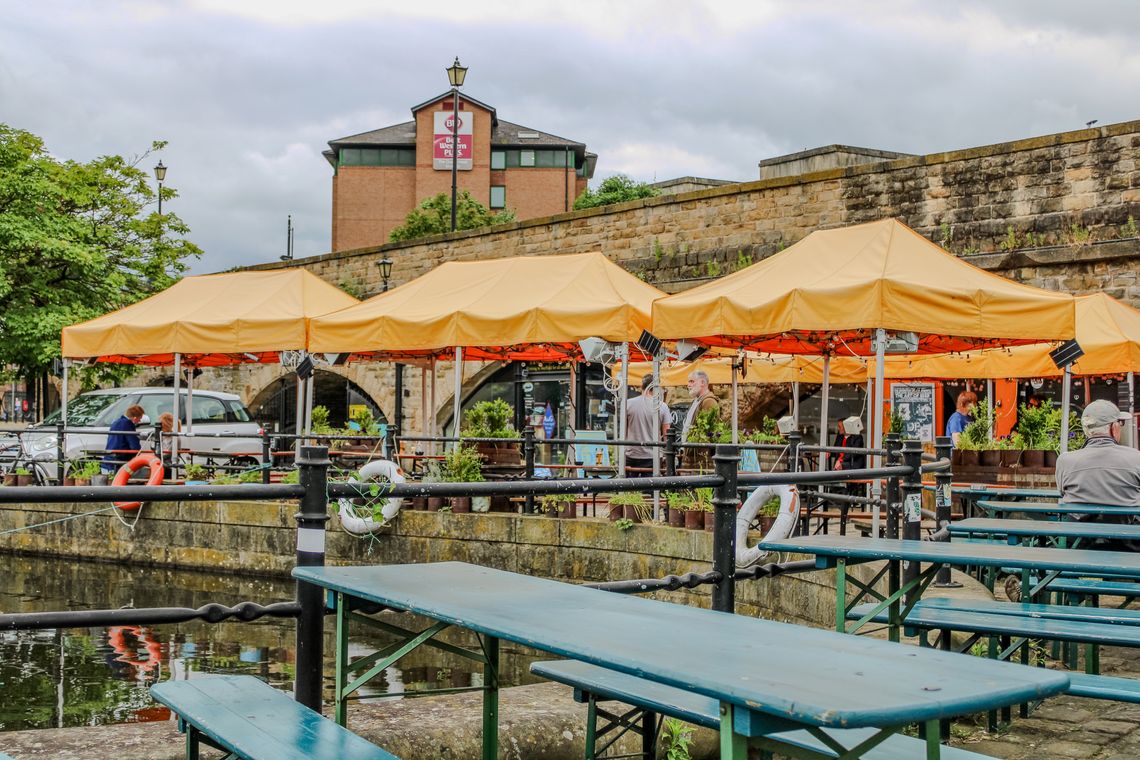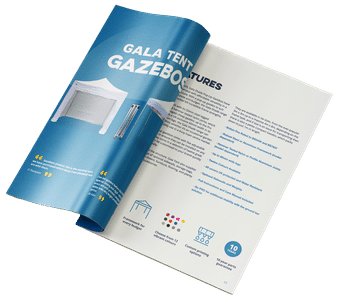How to Connect Two Gazebos Together
When you’re organising outdoor events, exhibitions, and gatherings, a well-planned and executed setup is paramount. Gazebos have long been a popular choice for their versatility, portability, and ability to provide shelter from the elements.
However, there may arise occasions where a single gazebo simply doesn't suffice – whether you're a market trader seeking a continuous stall, an event organiser aiming to create an expansive covered area, or a homeowner with an unconventional garden layout.
This is where the art of gazebo connectivity comes into play, allowing you to safely join multiple gazebos together, creating a unified and expansive space tailored to your specific needs.
When you might need to connect two or more gazebos together
The need to connect gazebos can arise in various scenarios, each presenting its own unique set of challenges and requirements. Let's explore some common situations where gazebo connectivity becomes a necessity:
Market Stalls and Trade Shows
For vendors and traders participating in bustling markets or trade shows, a continuous and cohesive stall setup is essential for attracting customers and showcasing their products effectively. By connecting multiple gazebos, you can create a visually appealing and uninterrupted space, enhancing your brand's presence and providing a seamless shopping experience for visitors.
Outdoor Events and Festivals
Outdoor events and festivals often require extensive covered areas to accommodate various activities, stages, and vendor booths. Connecting multiple gazebos allows event organisers to create a customised and adaptable layout, ensuring ample space for attendees while providing protection from the elements.
Residential and Commercial Settings
In residential or commercial settings, the need for a larger covered area may arise for various reasons, such as hosting a backyard party, setting up a temporary workspace, or creating a shaded seating area. Connecting gazebos offers a cost-effective and flexible solution, allowing you to tailor the space to your specific requirements without the need for a permanent structure.
Unique Garden Configurations
Gardens with unconventional layouts or irregular shapes can pose challenges when it comes to finding a suitable shelter solution. By connecting multiple gazebos, you can create a customised and adaptable structure that seamlessly blends with your garden's unique design, providing both functionality and aesthetic appeal.

Benefits of Connecting Gazebos
Beyond accommodating specific scenarios, connecting gazebos offers a range of practical benefits that make it a compelling choice:
Increased Coverage Area: By joining multiple gazebos, you can significantly expand the covered area, providing ample space for your intended activities or events.
Versatility and Flexibility: Gazebo connectivity allows you to tailor the layout and configuration to suit your specific needs, whether it's a linear arrangement, an L-shape, or a more complex design.
Cost-Effectiveness: Connecting gazebos can be a more cost-effective solution compared to investing in a single, large marquee or permanent structure, especially for temporary or occasional use.
Portability and Ease of Setup: Gazebos are designed for portability and easy assembly, making it convenient to transport and set up multiple units at different locations or events.
Enhanced Stability and Anchoring: By connecting gazebos, you effectively double the weight and anchoring points, resulting in improved stability and resistance against wind and other environmental factors.
Customisation Options: With a range of gazebo sizes, colors, and accessories available, you can create a cohesive and visually appealing setup that aligns with your brand or event theme. It's essential to lay the groundwork and gather the necessary components.
Here are some key steps to consider:
Assess Your Needs
Begin by evaluating your specific requirements, such as the desired coverage area, the number of gazebos needed, and any additional accessories or features you may require (e.g., sidewalls, lighting, flooring).
Choose Compatible Gazebos
To ensure a seamless connection, it's crucial to select gazebos from the same brand and series, as they are designed to be compatible with each other. This ensures a proper fit and reduces the risk of compatibility issues.
Gather Essential Accessories
In addition to the gazebos themselves, you'll need specialised accessories to facilitate the connection process. These may include:
Gazebo Connector Kits: These kits typically consist of clamps or brackets that securely join the legs of adjacent gazebos, ensuring a sturdy and stable connection.
Gutter Kits: Gutter kits are designed to create a waterproof channel between the roofs of connected gazebos, preventing water from seeping through the gaps and ensuring a dry and comfortable environment.
Plan the Layout
Before setting up, it's advisable to plan the desired layout and configuration of the connected gazebos. Consider factors such as foot traffic flow, accessibility, and any potential obstructions or obstacles in the area.
Enlist Assistance
Depending on the number of gazebos and the complexity of the setup, it may be beneficial to have additional hands on deck. Enlist the help of friends, family, or colleagues to ensure a smooth and efficient installation process.
With proper planning and the right accessories, you'll be well-prepared to embark on the journey of connecting gazebos, unlocking a world of possibilities for your outdoor events, trade shows, or residential needs.
Step-by-Step Guide: Connecting Gazebos
Now that you've laid the groundwork, it's time to dive into the step-by-step process of connecting gazebos. Follow these instructions carefully to ensure a seamless and secure setup:
1. Assemble the Gazebos Begin by assembling each individual gazebo according to the manufacturer's instructions. Ensure that all components are properly secured and that the frames are sturdy and level.
2. Position the Gazebos Arrange the gazebos in the desired configuration, aligning the legs that will be connected. It's essential to maintain a consistent spacing between the gazebos to facilitate the installation of the connector kits and gutter system.
3. Install the Connector Kits Refer to the instructions provided with your gazebo connector kits and follow the steps carefully. Typically, these kits involve clamping or bracketing the legs of adjacent gazebos together, ensuring a secure and stable connection.
4. Secure the Gutter System Once the gazebos are connected at the base, it's time to install the gutter system. Follow the manufacturer's guidelines for attaching the gutter components to the roof of each gazebo, creating a seamless channel for water to flow through.
5. Anchor the Structure To ensure the stability and safety of your connected gazebo setup, it's crucial to anchor the structure properly. This can be achieved using weight bags, ground stakes, or any other anchoring system recommended by the manufacturer.
6. Add Finishing Touches Depending on your specific needs, you may want to incorporate additional accessories or features to enhance the functionality and aesthetics of your connected gazebo setup. This could include sidewalls, lighting, flooring, or any other desired elements.
7. Conduct a Final Inspection Before declaring your setup complete, take the time to perform a thorough inspection. Check for any loose connections, ensure the gutter system is properly aligned, and verify that the anchoring points are secure. By following these steps meticulously, you'll be able to create a great unified gazebo setup, ready to accommodate your events with confidence and style.
The Importance of Gutter Kits
One of the primary concerns when connecting gazebos is ensuring adequate protection from the elements, particularly rain. This is where gutter kits come into play, serving as a crucial component in creating a waterproof and dry environment within your connected gazebo setup.Gutter kits are specialised accessories designed to bridge the gap between the roofs of adjacent gazebos, creating a continuous and waterproof channel for rainwater to flow through. These kits typically consist of a durable and weather-resistant material, such as poly/PVC coated fabric, shaped into a gutter-like structure.
Buy from Gala TentThe Role of Gazebo Connectors
While gutter kits play a crucial role in weather protection, gazebo connectors are equally important in ensuring the stability and structural integrity of your connected setup. These specialised accessories are designed to securely join the frames of adjacent gazebos, creating a cohesive and sturdy structure.Gazebo connectors, also known as framework connectors or clamps, are typically made of durable materials like steel or aluminum. They feature a clamping or bracketing mechanism that allows them to securely grip the legs or frame components of adjacent gazebos, effectively linking them together.
Buy from Gala Tent